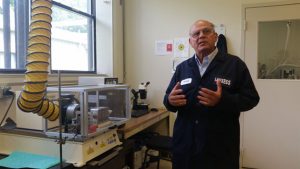
NAUGATUCK — German chemical company Lanxess says it plans on remaining in its facility at the old Uniroyal site for the long haul.
The Nudenberg-Wheeler Technical Center, comprised of two facilities at 400 Elm St. and 12 Spencer St., is within an eight-acre section of the 88-acre former Uniroyal compound. It hosts the company’s main North American research and development division for lubricant additives, flame retardants and urethanes business.
Lanxess acquired the facilities in April 2017 when it purchased the compound’s previous owner, Chemtura, for $2.1 billion.
“Out of Naugatuck, we are driving global innovations like reactive and polymeric flame retardants or new friction modifier additives,” said Anno Borkowsky, head of Lanxess’ additives business unit.
The company conducted a tour last Thursday of the Naugatuck facility, parts of which Chemtura spent $10 million renovating in 2011. Chemtura also installed an $800,000 tech center for flame retardants in 2016.
Lanxess recently announced the closure of a former Chemtura facility at 199 Benson Road in Middlebury that it acquired with the 2017 acquisition. The Middlebury operation, which employs about 130 people, will move to a smaller site at 2 Armstrong Road in Shelton by Sept. 4.
Lanxess spokeswoman Lisa Goldstone said the state-of-the-art facilities in Naugatuck, which the company owns, made the Middlebury location, which is leased, redundant and it was not cost-effective.
The move, she said, is not about “leaving the area; it’s reworking our presence here.”
David Sikora, head of polymer additives technology, said the company has plans for the property in Naugatuck — it is donating 80 acres to the borough to aid development of the planned Port of Naugatuck, a proposed inland port and intermodal transportation hub. The proposed port will be used to convey consumer goods for warehousing and distribution and allow international goods to go through customs in the borough.
Lanxess employs approximately 60 scientists and engineers in Naugatuck who work on research and development for the company’s lubricant and flame retardants businesses, which serve the military, industrial and consumer markets.
The chemical company has tabbed North America as a growth market, according to Goldstone, and it pledged $500 million in total investments on the continent at a recent board meeting.
Lanxess believes trends in the automobile and technology industries will increase demand for the lubricant additives and flame retardants the company produces.
Sikora said efforts to make cars more fuel-efficient will result in fewer metal components and more plastic in cars, which will require flame retardants. In addition, high demand for high-performance consumer technology (computers, smart phones) will drive demand as well, he said.
“These are trends that are not going to disappear,” Sikora said.
Cyril Migdal, global head of application technology, said Lanxess’ new organic friction modifier for car lubricants can improve fuel economy and increase wear protection, resulting in longer drain intervals.
“We’ve been able to get 5 percent fuel economy over reference lubricants, which for an individual is nice, but when you talk about a whole country or world that can get that, that becomes a significant amount of fuel savings,” he said.
Lanxess employs 19,200 employees in 25 countries at 75 production sites worldwide.













